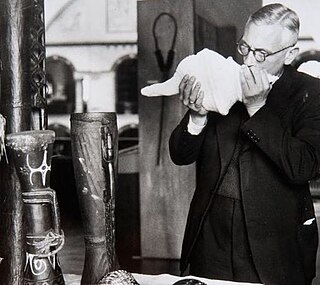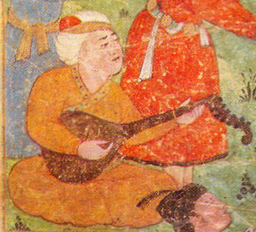Related Research Articles
The estampie is a medieval dance and musical form which was a popular instrumental and vocal form in the 13th and 14th centuries. The name was also applied to poetry.
Musicology is the scholarly study of music. Musicology research combines and intersects with many fields, including psychology, sociology, acoustics, neurology, natural sciences, formal sciences and computer science.

Ethnomusicology is the multidisciplinary study of music in its cultural context, investigating social, cognitive, biological, comparative, and other dimensions involved other than sound. Ethnomusicologists study music as a reflection of culture and investigate the act of musicking through various immersive, observational, and analytical approaches drawn from other disciplines such as anthropology to understand a culture’s music. This discipline emerged from comparative musicology, initially focusing on non-Western music, but later expanded to embrace the study of any and all different kinds of music of the world.

Isorhythm is a musical technique using a repeating rhythmic pattern, called a talea, in at least one voice part throughout a composition. Taleae are typically applied to one or more melodic patterns of pitches or colores, which may be of the same or a different length from the talea.

The sarabande is a dance in triple metre, or the music written for such a dance.
Bruno Nettl was an ethnomusicologist who was central in defining ethnomusicology as a discipline. His research focused on folk and traditional music, specifically Native American music, the music of Iran and numerous topics surrounding ethnomusicology as a discipline.

Charles Louis Seeger Jr. was an American musicologist, composer, teacher, and folklorist. He was the father of the American folk singers Pete Seeger (1919–2014), Peggy Seeger, and Mike Seeger (1933–2009); and brother of the World War I poet Alan Seeger (1888–1916) and children's author and educator Elizabeth Seeger (1889-1973).

Barbad was a Persian poet-musician, lutenist, music theorist and composer of Sasanian music. He served as chief minstrel-poet under the Shahanshah Khosrow II. A barbat player, he was the most distinguished Persian musician of his time and is regarded among the major figures in the history of Persian music.
Dastgāh is the standard musical system in Persian art music, standardised in the 19th century following the transition of Persian music from the Maqam modal system. A dastgāh consists of a collection of musical melodies, gushehs. In a song played in a given dastgah, a musician starts with an introductory gusheh, and then meanders through various different gushehs, evoking different moods. Many gushehs in a given dastgah are related to an equivalent musical mode in Western music. For example, most gushehs in Dastgāh-e Māhur correspond to the Ionian mode in the Major scale, whilst most gushehs in Dastgāh-e Šur correspond to the Phrygian mode. In spite of 50 or more extant dastgāhs, 12 are most commonly played, with Dastgāh-e Šur and Dastgāh-e Māhur being referred to as the mothers of all dastgahs.

Alan Parkhurst Merriam was an American ethnomusicologist known for his studies of music in Native America and Africa. In his book The Anthropology of Music (1964), he outlined and develops a theory and method for studying music from an anthropological perspective with anthropological methods. Although he taught at Northwestern University and University of Wisconsin, the majority of his academic career was spent at Indiana University where he was named a professor in 1962 and then chairman of the anthropology department from 1966 to 1969, which became a leading center of ethnomusicology research under his guidance. He was a co-founder of the Society for Ethnomusicology in 1952 and held the elected post of president of that society from 1963 to 1965. He edited the Newsletter of the Society for Ethnomusicology from 1952 to 1957, and he edited the journal Ethnomusicology from 1957 to 1958.

Hormoz Farhat was a Persian-American composer and ethnomusicologist who spent much of his career in Dublin, Ireland. An emeritus professor of music, he was a fellow of Trinity College, Dublin. Described by the Irish Times as a "gifted and distinctive composer of contemporary classical music," his compositions include orchestral, concertante, piano and choral music, as well string quartets and chamber works. He also wrote numerous film scores, including that of Dariush Mehrjui's 1969 film The Cow. However, his musicological research dominates his legacy; his writings on the music of Iran—a country which he insisted be called 'Persia'—were pivotal in ethnomusicology, particularly his acclaimed 1990 study The Dastgah Concept in Persian Music.
The Society for Ethnomusicology is, with the International Council for Traditional Music and the British Forum for Ethnomusicology, one of three major international associations for ethnomusicology. Its mission is "to promote the research, study, and performance of music in all historical periods and cultural contexts."
Harold Stone Powers was an American musicologist, ethnomusicologist, and music theorist.

Gerard Henri Luc Béhague was an eminent Franco-American ethnomusicologist and professor of Latin American music. His specialty was the music of Brazil and the Andean countries and the influence of West Africa on the music of the Caribbean and South America, especially candomblé music. His lifelong work earned him recognition as the leading scholar of Latin American ethnomusicology.
The Fumio Koizumi Prize is an international award for achievements in ethnomusicology, presented annually in Tokyo, Japan. The prize is awarded by the Fumio Koizumi (小泉文夫) Trust each April 4, the date of Fumio's birthday. The recipient receives an award certificate in addition to prize money. The winners must be present at the ceremony, deliver a prize lecture, and deliver another lecture at another Japanese university of his/her choice.

Philip Vilas Bohlman is an American ethnomusicologist.
A tetratonic scale is a musical scale or mode with four notes per octave. This is in contrast to a heptatonic (seven-note) scale such as the major scale and minor scale, or a dodecatonic scale, both common in modern Western music. Tetratonic scales are not common in modern art music, and are generally associated with prehistoric music.
Alejandro Luis Madrid-González is an American music scholar, cultural theorist, and professor, whose research focuses on Latino and Latin American musics and sound practices. He is the Walter W. Naumburg Professor of Music at Harvard University.
George Herzog was an American anthropologist, folklorist, musicologist, and ethnomusicologist.
Ethnomusicology is the study of music from the cultural and social aspects of the people who make it. It encompasses distinct theoretical and methodical approaches that emphasize cultural, social, material, cognitive, biological, and other dimensions or contexts of musical behavior, in addition to the sound component. While the traditional subject of musicology has been the history and literature of Western art music, ethnomusicology was developed as the study of all music as a human social and cultural phenomenon. Oskar Kolberg is regarded as one of the earliest European ethnomusicologists as he first began collecting Polish folk songs in 1839. Comparative musicology, the primary precursor to ethnomusicology, emerged in the late 19th century and early 20th century. The International Musical Society in Berlin in 1899 acted as one of the first centers for ethnomusicology. Comparative musicology and early ethnomusicology tended to focus on non-Western music, but in more recent years, the field has expanded to embrace the study of Western music from an ethnographic standpoint.
References
- ↑ Levin, Theodore (2001). "Blum, (Robert) Stephen". Grove Music Online. doi:10.1093/gmo/9781561592630.article.48746. ISBN 978-1-56159-263-0.
- ↑ "Nettl, Bruno". Grove Music Online.
- ↑ Nettl, Bruno; Blum, Stephen (September 1967). "Studies in Blackfoot Indian Musical Culture, Part II: Musical Life of the Montana Blackfoot, 1966". Ethnomusicology. 11 (3): 11–48. doi:10.2307/850267. JSTOR 850267., Retrieved February 11, 2014
- ↑ Blum, Stephen; Bohlman, Philip; Neuman, Daniel M. (1993). Ethnomusicology and Modern Music History. University of Illinois Press. ISBN 978-0-252-06343-5.
- ↑ Stephen Blum, "Persian Folksong in Meshhed (Iran), 1969," Yearbook of the International Folk Music Council, VI (1974), page 101.
- ↑ "Stephen Blum Collection of Music from Iranian Khorāsān". Harvard Library.